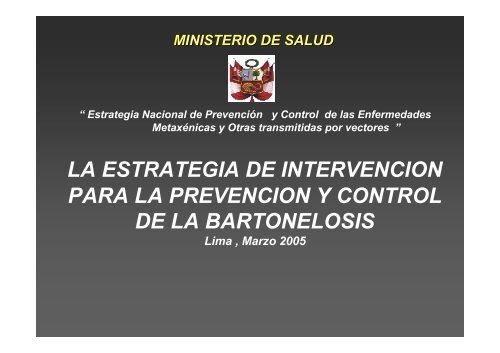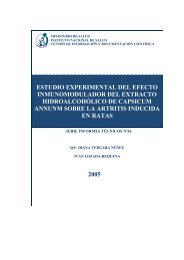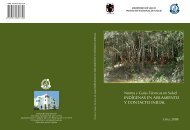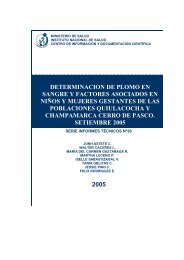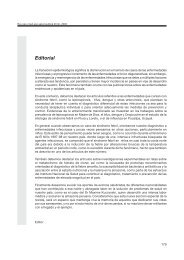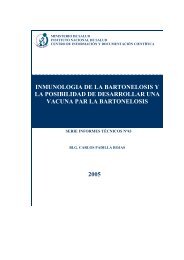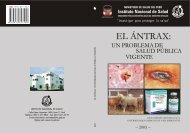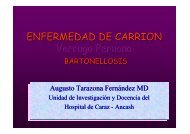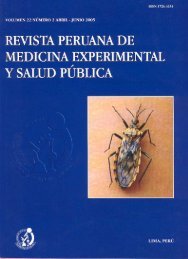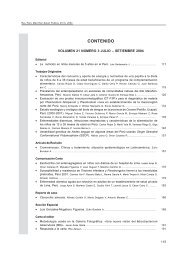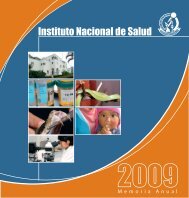la estrategia de intervencion para la prevencion y control de la ...
la estrategia de intervencion para la prevencion y control de la ...
la estrategia de intervencion para la prevencion y control de la ...
Create successful ePaper yourself
Turn your PDF publications into a flip-book with our unique Google optimized e-Paper software.
MINISTERIO DE SALUD<br />
“ Estrategia Nacional <strong>de</strong> Prevención y Control <strong>de</strong> <strong>la</strong>s Enfermeda<strong>de</strong>s<br />
Metaxénicas y Otras transmitidas por vectores ”<br />
LA ESTRATEGIA DE INTERVENCION<br />
PARA LA PREVENCION Y CONTROL<br />
DE LA BARTONELOSIS<br />
Lima , Marzo 2005
ENFOQUE DEL CONTROL DE LA MALARIA<br />
CONTROL DE LA VIA DE TRANSMISION<br />
VECTOR ADULTO<br />
Reor<strong>de</strong>namiento <strong>de</strong>l medio<br />
Control Químico: Cuando los hábitos <strong>de</strong>l<br />
vector aseguren el contacto con el Insecticida<br />
CONTROL DE LA<br />
FUENTE DE<br />
INFECCION<br />
•Diagnóstico y<br />
Tratamiento.<br />
•Tamizaje<br />
•Mosquiteros<br />
impregnados<br />
HUMANO<br />
PORTADOR<br />
TRANSMISION<br />
VECTOR<br />
HUMANO<br />
SUSCEPTIBLE<br />
CONTROL DE LA VIA DE<br />
TRANSMISION FASE LARVARIA<br />
•Reor<strong>de</strong>namiento <strong>de</strong>l medio<br />
•Larvicidas<br />
•Eliminación <strong>de</strong> cria<strong>de</strong>ros<br />
•Modificación <strong>de</strong> cria<strong>de</strong>ros<br />
•Control biológico<br />
PROTECCION<br />
DEL<br />
SUSCEPTIBLE<br />
•Mosquiteros<br />
impregnados<br />
•Mal<strong>la</strong>s metálicas<br />
•Hábitat<br />
•Quimioprofi<strong>la</strong>xis<br />
•Educación<br />
•Vacunación?
Apertura <strong>de</strong> frontera<br />
norte, Acuerdo Perú-<br />
Ecuador<br />
movilización <strong>de</strong><br />
personas y reservorios<br />
Expansión <strong>de</strong><br />
rutas <strong>de</strong><br />
comunicación<br />
y comercio.<br />
Ma<strong>la</strong>ria<br />
Arbovirus FA<br />
Política <strong>de</strong><br />
promoción <strong>de</strong><br />
exportaciones no<br />
Tradicionales.<br />
Puertos costeños,<br />
comercio<br />
artesanal<br />
TUM BES<br />
P IURA<br />
LAM BAY EQ UE<br />
CALLAO<br />
CAJAMARCA<br />
LIMA CIUDAD<br />
Expansión <strong>de</strong> rutas <strong>de</strong><br />
comunicación, comercio<br />
y penetración.<br />
Ma<strong>la</strong>ria y Arbovirus<br />
Arroz 300,000<br />
Htas. Cultivadas,<br />
aumenta riesgo <strong>de</strong><br />
Ma<strong>la</strong>ria<br />
AMAZ ONAS<br />
LA LI BE RTAD<br />
ANCAS H<br />
S AN<br />
M ART ÍN<br />
LIMA NORTE<br />
HUÁNUCO<br />
LIMA ES TE<br />
LIMA SUR<br />
ICA<br />
P AS CO<br />
JUNÍN<br />
LO RE TO<br />
HUANCAVELICA<br />
AYACUCHO<br />
Procesos Sociales y Económicos<br />
Intervinientes en <strong>la</strong> Transmision <strong>de</strong><br />
<strong>la</strong>s Metaxénicas<br />
UCAYALI<br />
APURÍMAC<br />
CUSCO<br />
AREQUIPA<br />
M ADRE DE<br />
DIO S<br />
MOQUEGUA<br />
Erradicación cultivo<br />
coca y sustitución <strong>de</strong><br />
cultivos. Ceja <strong>de</strong><br />
Selva. 8 cuencas,<br />
400.000 personas.<br />
Riesgo <strong>de</strong> FA<br />
P UNO<br />
TACNA<br />
Explotación <strong>de</strong>l<br />
Gas <strong>de</strong> Camisea.<br />
200,000 personas<br />
en nuevos nichos<br />
ecológicos<br />
Apertura <strong>de</strong><br />
frontera sur,<br />
movilización <strong>de</strong><br />
personas y<br />
reservorios
Bartonelosis en el Perú 1945 –<br />
2005*(SE08)<br />
Tasa <strong>de</strong> Inci<strong>de</strong>ncia - Curva Histórica<br />
36.00<br />
32.00<br />
28.00<br />
Tasa x 100 000 hab.<br />
24.00<br />
20.00<br />
16.00<br />
12.00<br />
Año 2004:<br />
Casos : 8,883 (A+V+P)<br />
T.I. : 32 x 100,000hab.<br />
T.M. : 0.18 x 100,000 hab.<br />
8.00<br />
4.00<br />
0.00<br />
1945<br />
1947<br />
1949<br />
1951<br />
1953<br />
1955<br />
1957<br />
1959<br />
1961<br />
1963<br />
Fuente: Ministerio <strong>de</strong> Salud – ESN-Metaxenicas - DGSP<br />
1965<br />
1967<br />
1969<br />
1971<br />
1973<br />
1975<br />
Años<br />
1977<br />
1979<br />
1981<br />
1983<br />
1985<br />
1987<br />
1989<br />
1991<br />
1993<br />
1995<br />
1997<br />
1999<br />
2001<br />
2003<br />
2005
Bartonelosis según Distritos Afectados -2004<br />
Fuente: Ministerio <strong>de</strong> Salud<br />
Bartonelosis<br />
17.31 - 34.61<br />
34.61 - 242.3<br />
242.3 - 4845.97<br />
Sin datos
Persistencia <strong>de</strong> Transmisión<br />
<strong>de</strong> Bartonelosis en el Perú<br />
1:Persistencia<br />
<strong>de</strong> Condiciones<br />
Socio-<br />
Ambientales<br />
<strong>para</strong> el<br />
<strong>de</strong>sarrollo <strong>de</strong><br />
<strong>la</strong>s EMs<br />
2: Respuesta<br />
Inapropiada<br />
<strong>de</strong> los<br />
servicios <strong>de</strong><br />
salud.<br />
3: Estilos <strong>de</strong><br />
vida<br />
favorables a<br />
<strong>la</strong><br />
transmisión
1: Persistencia <strong>de</strong> Condiciones Socio-<br />
Ambientales <strong>para</strong> el <strong>de</strong>sarrollo <strong>de</strong> <strong>la</strong>s EMs<br />
1.1 Existencia <strong>de</strong><br />
Reservorios<br />
Humanos<br />
1.2 Alta<br />
<strong>de</strong>nsidad<br />
vectorial<br />
1.3 Insuficiente<br />
participación<br />
social<br />
1.1.1Tratamiento<br />
ina<strong>de</strong>cuado<br />
1.1.2Falta <strong>de</strong> acceso<br />
a los servicios <strong>de</strong><br />
salud<br />
1.1.3<br />
Resistencia a<br />
drogas AMA<br />
Pobreza<br />
Dispersión<br />
pob<strong>la</strong>cional<br />
Barrera<br />
cultural
1: Persistencia <strong>de</strong> Condiciones Socio-<br />
Ambientales <strong>para</strong> el <strong>de</strong>sarrollo <strong>de</strong> <strong>la</strong>s EMs<br />
1.1 Existencia <strong>de</strong><br />
Reservorios<br />
Humanos<br />
1.2 Alta<br />
<strong>de</strong>nsidad<br />
vectorial<br />
1.3 Insuficiente<br />
participación<br />
social<br />
1.2.1 Cria<strong>de</strong>ros<br />
cercanos a <strong>la</strong><br />
pob<strong>la</strong>ción<br />
1.2.2 Acciones<br />
<strong>de</strong> <strong>control</strong><br />
vectorial<br />
<strong>de</strong>ficientes<br />
1.2.3 Resistencia<br />
<strong>de</strong>l vector<br />
1.2.4Variacion<br />
estacional<br />
favorable <strong>para</strong><br />
transmisión<br />
Incumplimien<br />
to <strong>de</strong> <strong>la</strong><br />
norma<br />
sanitaria<br />
Escaso conocimiento<br />
<strong>de</strong> los riesgos<br />
ambientales (según<br />
escenarios)<br />
Insuficiente<br />
accion <strong>de</strong> li<strong>de</strong>res<br />
y gobiernos<br />
locales<br />
Falta <strong>de</strong><br />
mantenimiento <strong>de</strong><br />
<strong>la</strong> infraestructura<br />
<strong>de</strong> riego
1: Persistencia <strong>de</strong> Condiciones Socio-<br />
Ambientales <strong>para</strong> el <strong>de</strong>sarrollo <strong>de</strong> <strong>la</strong>s EMs<br />
1.1 Existencia <strong>de</strong><br />
Reservorios<br />
Humanos<br />
1.2 Alta<br />
<strong>de</strong>nsidad<br />
vectorial<br />
1.3 Insuficiente<br />
participación<br />
social<br />
1.3.1 Insuficiente<br />
sensibilización <strong>de</strong><br />
los li<strong>de</strong>res sobre <strong>la</strong><br />
salud <strong>de</strong> <strong>la</strong><br />
pob<strong>la</strong>ción<br />
1.3.2 Cultura<br />
paternalista<br />
populista<br />
estatal<br />
1.3.3 La salud<br />
no esta en<br />
agenda <strong>de</strong> <strong>la</strong>s<br />
organizaciones<br />
3.4 Precario<br />
conocimiento <strong>de</strong><br />
<strong>la</strong> salud publica<br />
<strong>de</strong> <strong>la</strong> pob<strong>la</strong>ción<br />
3.5 Deficiente<br />
ejercicio <strong>de</strong> <strong>la</strong><br />
ciudadanía en<br />
salud<br />
3.5 Ina<strong>de</strong>cuada<br />
conducción <strong>de</strong> <strong>la</strong><br />
participación social por<br />
parte <strong>de</strong>l sector salud
Tasa x 100,000<br />
0.18<br />
TASA DE MORTALIDAD POR BARTONELOSIS<br />
PERU 1996-2004<br />
0.16<br />
0.14<br />
0.12<br />
0.10<br />
0.08<br />
0.06<br />
0.04<br />
0.02<br />
0.00<br />
1996 1997 1998 1999 2000 2001 2002 2003 2004<br />
Tasa 0.01 0.08 0.10 0.12 0.08 0.06 0.17 0.13 0.18<br />
Fuente: Ministerio <strong>de</strong> Salud<br />
Año
HISTORICO DE ROCIADO DE VIVIENDAS, PERU 1997 - 2004<br />
3 0 0 ,0 0 0<br />
285,414<br />
2 5 0 ,0 0 0<br />
N ° V i v i e n d a s<br />
2 0 0 ,0 0 0<br />
1 5 0 ,0 0 0<br />
1 0 0 ,0 0 0<br />
5 0 ,0 0 0<br />
-<br />
157,474<br />
83,513<br />
67,258<br />
54,519<br />
39,074<br />
21,870<br />
12,589<br />
1 9 9 7 1 9 9 8 1 9 9 9 2 0 0 0 2 0 0 1 2 0 0 2 2 0 0 3 2 0 0 4 c<br />
AÑOS
CASOS VS ROCIAMIENTOS PARA EL CONTROL DE LA BARTONELOSIS<br />
EN LA DISA JAEN - AÑO 2004<br />
2000<br />
1800<br />
1600<br />
1400<br />
1200<br />
1000<br />
800<br />
600<br />
400<br />
200<br />
0<br />
I II III IV<br />
T R IM EST R E<br />
5000<br />
4500<br />
4000<br />
3500<br />
3000<br />
2500<br />
2000<br />
1500<br />
1000<br />
500<br />
0<br />
CASOS<br />
ROCIAM IENTOS
CASOS VS. ROCIAMIENTOS PARA EL CONTROL DE LA BARTONELOSIS EN LA DISA<br />
ANCASH - AÑO 2004<br />
1200<br />
1000<br />
800<br />
600<br />
400<br />
200<br />
0<br />
I II III IV<br />
T R IM EST R E<br />
14000<br />
12000<br />
10000<br />
8000<br />
6000<br />
4000<br />
2000<br />
0<br />
CASOS<br />
ROCIAMIENTOS
Situación Comunicación Social Bartonelosis<br />
• Intervención Comunicacional:<br />
Campaña <strong>de</strong> Prevención y Control <strong>de</strong> <strong>la</strong> Bartonelosis<br />
Nov. – Dic. 2004. Mensaje principal <strong>de</strong> campaña:<br />
”Limpia tu casa, <strong>de</strong>shierba los alre<strong>de</strong>dores y usa mosquitero<br />
<strong>para</strong> protegerte <strong>de</strong> <strong>la</strong> Manta B<strong>la</strong>nca”.<br />
Fecha <strong>de</strong> inicio y término <strong>de</strong> ejecución:<br />
Mes <strong>de</strong> Nov. 2004 a Diciembre 2004<br />
. Lugar <strong>de</strong> intervención: 1era zona Ancash, Bagua, Jaén,<br />
Amazonas, Cutervo y 2da zona Piura I, La Libertad, Lambayeque,<br />
Chota, Cajamarca y Cusco.<br />
Costo <strong>de</strong> <strong>la</strong> intervención comunicacional: S/.30,000 nuevos soles<br />
<strong>para</strong> sostenibilidad y S/.19,300 en material comunicacional.<br />
Fuentes <strong>de</strong> Financiamiento: MINSA-OGC / OGE
Situación Comunicación Bartonelosis<br />
Conclusiones :<br />
• 30 % <strong>de</strong> 63,336 <strong>de</strong> <strong>la</strong> pob<strong>la</strong>ción en general expuestos a <strong>la</strong><br />
información (Fuente: Informes e indicadores DIRESAS –<br />
Comunicaciones 2004).<br />
• Esta Campaña se constituyó en una primera experiencia en<br />
establecer el discurso comunicacional nacional en este tema<br />
con el apoyo técnico <strong>de</strong> Epi<strong>de</strong>miología, <strong>la</strong> Estrategia y los<br />
niveles locales.<br />
• Se estableció los siguientes comportamientos: Limpia tu<br />
casa, <strong>de</strong>shierba los alre<strong>de</strong>dores y usa mosquiteros <strong>para</strong><br />
protegerte <strong>de</strong> <strong>la</strong> manta b<strong>la</strong>nca.
INDICADORES CONCERTADOS<br />
BARTONELLA:<br />
• Tasa <strong>de</strong> Morbilidad por Bartonellosis<br />
Numerador: Numero <strong>de</strong> casos agudos (probables +<br />
confirmados <strong>de</strong> bartonel<strong>la</strong>)<br />
Denominador: Pob<strong>la</strong>ción total<br />
• Tasa <strong>de</strong> Letalidad por Bartonellosis<br />
Numerador: Numero <strong>de</strong> fallecidos por Bartonel<strong>la</strong><br />
Denominador: Total <strong>de</strong> casos <strong>de</strong> Bartonel<strong>la</strong>
BARTONELLOSIS: Morbilidad por<br />
Bartonellosis<br />
DISAS<br />
Situación Basal<br />
Meta DISA Propuesta<br />
2000 2001 2002 2003 2004* 2005 2006 2007 2008 2009<br />
AMAZONAS 15 17 1 13<br />
BAGUA 77.44 73.40 132.90 74.47 110 100 90 80 70<br />
CAJAMARCA I 0 0 3 12 10 8 6 5 3<br />
CUTERVO* 18 120 180 98 120 100 90 85 80 80<br />
CHOTA 0 0 0 0 44 30 20 0 0 0<br />
JAEN 46 48.22 285.9 336.4 300 250 200 150 100<br />
LAMBAYEQUE 0 0 80 29 118 100 50 30 20
BARTONELLOSIS: Letalidad por<br />
Bartonellosis<br />
DISAS<br />
Situación Basal<br />
Meta DISA Propuesta<br />
2000 2001 2002 2003 2004* 2005 2006 2007 2008 2009<br />
AMAZONAS 5.9 0 0 15.38 2.08 2 2 2 2 2<br />
BAGUA 5.7 2.4 3.4 1.6 2 1 0 0 0<br />
CAJAMARCA I 1 2 1 1 0 0 0<br />
CUTERVO* 10.3 0 1.37 0 4.4 4 3.7 3.2 2.8 1.3<br />
CHOTA 0 0 0 0 11.36 0 0 0 0 0<br />
JAEN 6.2 1.36 2 1.22 1 0.9 0.8 0.7 0.5<br />
LAMBAYEQUE 0 0 12.5 0 0 0 0 0 0 0<br />
LA LIBERTAD 12.5 0 3.57 0.07 0 0 0 0 0 0<br />
LORETO - - - - - - - - - -<br />
PIURA I 5.4 4.9 2.3 5.7 0.7


